Christmas
![]()
The title of this article is ambiguous. For other meanings, see Christmas (disambiguation).
![]()
Christmastide and Nativity are redirections to this article. For other meanings, see At Christmastime and Birth of Jesus.
In Christianity, Christmas, also known as Christmastide or the Feast of the Holy Christ, is the celebration of the birth of Jesus Christ. The feast day is December 25, Christ Day, also High Feast of the Nativity of the Lord (Latin Sollemnitas in nativitate Domini), whose celebrations begin on the eve of Christmas Eve (also Christmas Eve, Holy Night, Christmas Night, Christmas Eve). December 25 is a public holiday in many states. In Germany, Austria, the Netherlands, Switzerland and many other countries, the second Christmas holiday is December 26, which is also celebrated as St. Stephen's Day.
Christmas is usually celebrated with family or friends and with giving gifts to each other, called Bescherung. In German-speaking and some other countries, Bescherung usually takes place in the evening of December 24 and is considered the most prominent part of Christmas. In English-speaking countries, Bescherung usually takes place on the morning of Christmas Day. The gift-giving ritual makes reference to mythical gift-bringers such as the Christ Child or Santa Claus, some of whom are also played. Such rites, like the festival as a whole, serve to strengthen family relationships. Many countries associate other customs of their own with Christmas.
Attending a church service on Christmas Eve, the night or morning of December 25 is part of the festive tradition for many people; in Germany, this applies to one fifth of the population (2016 and 2018).
In Western Christianity, Christmas is one of the three main festivals of the church year, along with Easter and Pentecost. December 25 has been documented as an ecclesiastical holiday in Rome since 336. It is not clear how this date came about. It is discussed that it was influenced by the Roman sun cult: Emperor Aurelian had set December 25, 274, as an empire-wide feast day for the Roman sun god Sol Invictus; early Christians drew parallels between this sun god and "Christ, the true sun" (Christus verus Sol).
The custom of giving presents to children at Christmas in the way that is customary today dates back to the Biedermeier period and was initially restricted to upper middle-class circles, for only these had the living room used like a stage at their disposal, could afford a private Christmas tree and could choose children's presents from the increasingly varied range of toys.

A Christmas or Christmas tree
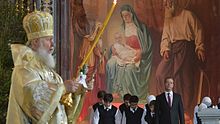
Christmas service at the Cathedral of Christ the Saviour in Moscow on January 7, 2016.
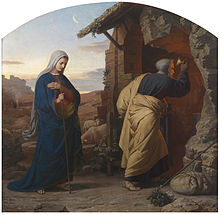
Michael Rieser: On the evening before Christ's birth (1869)
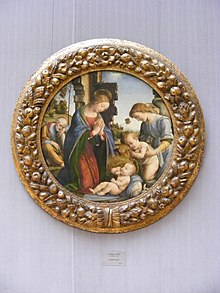
Fra Bartolommeo: The Holy Family with the Boy John (c. 1490; Alte Pinakothek, Munich)
Etymology
The High German expression Christmas goes back to a Middle High German adjectival phrase wîhe naht or ze (den) wîhen nahten, the earliest record of which is found in the sermon collection Speculum ecclesiae (c. 1170).
"diu gnâde diu anegengete sih an dirre naht: von diu heizet si diu wîhe naht."
"Grace came to us this night: therefore it is called the holy night."
The verses from a long poem by the Bavarian poet Spervogel (c. 1190) date from the same period:
"He is mighty and strong, who was born in the near of death, and is the holy Krist."
"He is mighty and strong, who was born to the consecrated [hallowed] night: this is the holy Christ."
The expression remained restricted to the Upper German area until the 13th century and is attested in the Middle German dialects only since the end of that century as wînahten. In addition, christtag appears as a synonym in Middle German from Thuringia and Upper Hesse via Westphalia to Luxembourg and Lorraine. In Middle Low German, the words kersnacht "Christnacht" and kerstesmisse "Christmesse" (cf. English Christmas) are found instead, only from 1340 winachten (m.). In eastern North Germany, the mnd. jûl has survived into more recent times as Jul.
The adjective Old High German and Old Saxon wîh, Middle High German wîch is derived via Germanic *wīʒja, wīhaz 'holy, consecrated, numinos' from the Indo-European word root *ueik 'to separate, to consecrate' and resulted in New High German in a now uncommon soft 'holy'. In turn from this adjective was derived the weak verb wîhen (Ahd. and Mhd. homonymous, from Germanic *wīʒjan, wīhijaną) and finally the New High German weihen. A nounification of the adjective yielded Old Saxon and Old High German wîh 'temple', Old English wēoh, wīg 'image of the gods', and Old Norse vē 'sanctuary, temple, place of judgment' (cf. the Norse deity Vé). Moreover, wîh is probably related to Latin victima 'sacrificial animal' and Old Lithuanian viešpilas 'sacred mountain'. The second word element nahten on the one hand ties in with the old division of time from day with the beginning of night (cf. English fortnight 'fourteen days'), and on the other hand the plural refers to several holidays - perhaps with reference to the Old Church tradition of the Twelve Days of Christmas from 25 December to Epiphany on 6 January or the European custom of the Rauhnächte. The compound word can thus be translated as the holy nights.
The impersonal verb weihnachten was coined by Theodor Storm. In his poem of Knecht Ruprecht, the opening and closing lines read:
From out of the woods I come;
I must tell you, it's very Christmassy!
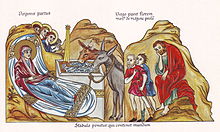
The birth of Jesus Christ, depiction from the Hortus Deliciarum of Herrad of Landsberg (12th century)
Origin of other Christmas motifs
Child of God and Child God
The motif of the divine begetting of great men and heroes preceded Christianity in religious history. From it the belief in a virgin birth resulted to some extent logically, which is found in ancient Iran as the virginal conception of the eschatological saviour Saoschjant as well as implicitly in the Danaë myth and the procreation legends around Plato or Alexander the Great. However, it always remained with a bodily imagined conception of the respective son of God, who was not always presented as the redeemer of the world.
The idea of the annual rebirth of a god was also known from Egyptian and Greek mythology, where it was linked to the cycle of the seasons and vegetation, especially in the myths of Osiris and Dionysus.
Karl Kerényi characterized the first phase of Dionysus' life as "the divine child in the cave, surrounded by female care. Worshipped in that phase as the secret content of the cereal wing." An important source for this is the Orphic Hymns. In the 46th Orphic Hymn, Dionysus is addressed by the epithet Liknítes (Λικνίτης), derived from ancient Greek λίκνον líknon "grain-wing", a cult object of the Dionysus Mysteries. Dionysus Liknites was worshipped at Delphi, where he was the chief deity during the winter months in the absence of Apollo. The hymn speaks of sleeping and awakening, or the birth of Dionysus. The metaphor of blossoming connects Orpheus with the plant world. The corresponding ritual of the Mysteries probably consisted of bringing in a wing of grain and revealing its contents. The 53rd Orphic Hymn shows unusual elements, probably explained by the fact that a Phrygian cult was associated with Dionysus. Only here within the Orphic Hymns is Dionysus referred to as a chthonic deity: he sleeps in the underworld (the halls of Persephone) and is awakened by the cult participants, corresponding to the beginning of vegetation in spring. In the Orphic Fragments, Dionysus is identified with Phanes, who is born in a cave. Diodorus also knew this equation of Phanes and Dionysus, moreover that "some" identified Osiris and Dionysus. According to the Suda, some dying and resurrecting gods could be equated: Osiris, Adonis, and Aion.
Authors of the early imperial period mention a birth festival of the Egyptian deity Osiris on January 6 and a festival in honor of Dionysus on the island of Andros on the same day.
Through the Philosophumena an element of the mysteries of Eleusis is known: In the exclamation "a holy son has the mistress borne, Brimo the Brimos" culminated there a nocturnal ritual. Brimo could be identified in antiquity with Persephone, her child Brimos with Dionysus.
The Cypriot bishop Epiphanios of Salamis wrote in the 4th century AD that in Alexandria the birth of Aion was celebrated in the sanctuary of Kore at the same time as the Christian feast of Epiphany (i.e. in the night from January 5 to 6). Kore had the title "virgin" among her worshippers, which Epiphanios, probably incorrectly, understood in terms of the Christian dogma of the virgin birth. The Ugaritic deity Anat, whose cult came to Egypt early, could be called "virgin" to emphasize her youth and fertility, and Isis was "virgin" when identified with the constellation Virgo; neither goddess was considered sexually abstinent. According to Pausanias, Hera renews her virginity annually by bathing in a sacred spring. What Epiphanios described was an originally Dionysian cult that had absorbed elements of other cults in the cosmopolitan environment of Alexandria, possibly including Egyptian and Christian ideas.
According to Carl Gustav Jung and Karl Kerényi, the "child-god" has an archetypal quality. According to the dialectical formula "smaller than small, yet greater than great," he stands in close relationship to the adult hero. The child's initial abandonment, his "unsightly beginning", is nevertheless connected with the "mysterious and wonderful birth" and the "invincibility of the child". Jarl Fossum emphasizes that a newborn child stands for the future. The idea that Zeus gave the Dionysus boy dominion over the gods was therefore claimed by various rulers, combined with the idea that a new age would begin with their accession to power. Thus Emperor Antoninus Pius had coins minted as the "new Dionysus", referring to the rebirth of the phoenix and the deity Aion.
The Christmas story is not (at least not explicitly) located in a cave in the Gospels. But the Bethlehem birth cave tradition is old compared to other Christian pilgrimage traditions:
- Justin Martyr, around 150 AD, was the first author to mention the cave birth of the Christ, justifying it biblically with the Septuagint version of Isa 33:16a: "[A righteous man] will dwell in a high cave of a mighty rock." He was aware that the Mithras worshippers taught the birth of their deity from hard stone in a cave; to him, the similarity to the Bethlehem birth-cave tradition was a devilish deception.
- Also in the middle of the 2nd century, the Protoevangelium of James fleshed out the birth scene in the cave in a legendary way. This work was widely read in late antiquity and the Middle Ages and had a great influence on Christian art.
- By the middle of the 3rd century, a cave near Bethlehem had become a Christian pilgrimage site, which Origen probably knew from his own experience. "And what is shown there is a well-known thing in these parts even among non-Christians, so that they know that in this cave Jesus, adored and admired by Christians, was born."
- In tension with this is what Jerome, who lived in Bethlehem, wrote in retrospect in the 4th century: "A sacred grove of Thammuz, also called Adonis, shaded our Bethlehem, the most exalted place in the whole world, of which the Psalmist writes: Truth sprouted from the earth. In the cave where Christ once wept as a babe, the lover of Venus was wept for."
- The Bethlehem Cave was claimed for Christian worship in 326 by Emperor Constantine, who had a basilica built over it, the Church of the Nativity.
Whether the Christmas festival is to be interpreted as the adoption of older ideas of other religions or as the displacement of parallel cults remains controversial. The influence of the ancient representations of Dionysus, Isis, Osiris and their common son Horus on Christian iconography seems at least plausible.
Promise of the royal child as a sign of hope
In the prophecy of a royal child in the book of Isaiah, chapter 7, the ancient Jewish translation into Greek (Septuagint) deviates several times from the Hebrew text, which is normative in Judaism (Masoretic Text). These deviations are underlined in the following text.
"Therefore the Lord Himself will give you a sign; behold, the virgin will be with child and bear a son..."
- Isa 7:14 EU (Septuagint)
Instead of ancient Greek παρθένος parthénos "virgin," the Masoretic Text offers Hebrew עַלְמָה 'almāh "young woman, girl, servant." "Virgin," however, is not as strongly emphasized in the Septuagint text as one might suppose in view of the Christian history of interpretation; rather, the word may refer generally to a "young woman of marriageable age." Thus, in the Septuagint translation of Gen 34:3, Dina, who was raped, is referred to as parthénos. In the context of Isa 7, the translator probably preferred parthénos to ancient Greek νεᾶνις neãnis "girl" because this latter word has the connotation of "servant" and was intended to emphasize that a socially superior young woman gave birth to the royal child.
A similar, but probably unrelated idea is found in the fourth eclogue of the Roman poet Virgil. The poet announces an imminent change of times. The coming golden age is symbolized in the birth of a boy:
| iam redit et Virgo, redeunt Saturnia regna; iam nova progenies caelo demittitur alto. | Already the virgin returns, and again the kingdom of Saturnus, already new offspring is sent from the heights of heaven. |
Vergil dated the fourth eclogue to the year 40 BC (consulate of Asinius Pollio) and thus to the time of the Roman civil wars after the assassination of Caesar. Vergil was party: his collection of pastoral poems celebrated Octavian, the young emperor, without mentioning his name. In this cycle, the fourth eclogue announced to all mankind the beginning of a paradisiacal time under Octavian's rule. If Eclogue 4 was a kind of riddle (which boy is the poet talking about?), in the Aeneid Vergil put an answer in the mouth of Anchises, according to Niklas Holzberg: "This is the man, this is he, who, as you often hear, will promise you, Augustus Caesar, son of a god, who will found the Golden Age anew for Latium..."
The text of the 4th eclogue is dark. The "new offspring" (nova progenies) is mostly interpreted in the light of Hesiod's conception according to which a new human race comes into being in every age. Others identify the "offspring" with the boy (puer) addressed later in the poem; this remains ambivalent. In the Christian adaptation of this verse, the individual interpretation predominates: the child is equated with Christ (e.g. Lactantius). But there is also the collective interpretation to the church or the sex of the baptized. The late antique poet Prudentius connected Virgil's formulation with a concept of Paul of Tarsus: Christ is the new Adam, in whose resurrection body the Christians have a share.
The magicians and the star
The persons referred to in common Bible translations as "wise men" (Luther Bible) or "stargazers" (Einheitsübersetzung, Zurich Bible) are ancient Greek μάγοι mágoi in the original text of Matthew's Gospel, "wise men and priests who understood stargazing, dream interpretation, and other secret arts."
The classical philologist and religious scholar Albrecht Dieterich suggested that the motif in the special material of Matthew's Gospel of magi from the East paying homage to the newborn king of the Jews was neither legend nor myth; "it is the effect of a generally exciting and long known historical event." In A.D. 66, the Armenian king, Trdat I. (Tiridates) went to Rome and paid homage to Emperor Nero with proskynesis. This is reported by Cassius Dio, Suetonius and Pliny the Elder. Tiridates was described by Pliny as a "magician" in this context: "The magician Tiridates had come to him and delivered in his own person the triumph over Armenia ... He had brought magicians with him and even initiated 'Nero' into the meals of the magicians, yet the latter failed ... to learn this art." Trdat returned to his homeland by other means, as did the magicians in the Gospel. Dieterich thought that this historical event must have circulated orally among the people "in a longer tradition and gradually formed itself." He connected this with a late dating of the Matthean infancy narratives to the 2nd century. Only at this time the story of the homage of the magicians was "inserted" into the Gospel of Matthew.
The astrology and astronomy historian Franz Boll also pointed out that the episode with the star was conceived as a miracle story and was based on the ideas of the time that a star appeared in the sky with the birth of a person, which went out again with that person's death. According to ancient ideas, the star was bigger and brighter the more important the person in question became in his life.
For other suggestions of an astronomical or astrological interpretation of the star motif, see the main article Star of Bethlehem.

Birth of Dionysus on Mount Nysa, mosaic in the "House of Aion", Paphos (4th century A.D.)

The Education of Dionysus, Roman fresco, c. 20 A.D. (now in the Museo Nazionale Romano)
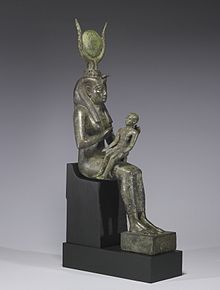
Isis with the Horus Boy, bronze statuette (c. 660 BC; Walters Art Museum, Baltimore).
Questions and Answers
Q: What does the word "Christmas" mean?
A: Christmas is derived from the phrase “The Mass of Christ” and is a Christian holiday that celebrates the birth of Jesus.
Q: When is Christmas Day celebrated?
A: Christmas Day is celebrated on the 25th day of December.
Q: What other important day do Christians celebrate besides Christmas?
A: Christians also celebrate Easter, which commemorates the death and resurrection of Jesus.
Q: When does Advent begin?
A: Advent begins on a Sunday about four weeks before Christmas.
Q: How long does Christmastide last for?
A: The season of Christmastide lasts until 6 January, also known as Twelfth Day of Christmas. On this day, Christians celebrate Epiphany.
Search within the encyclopedia